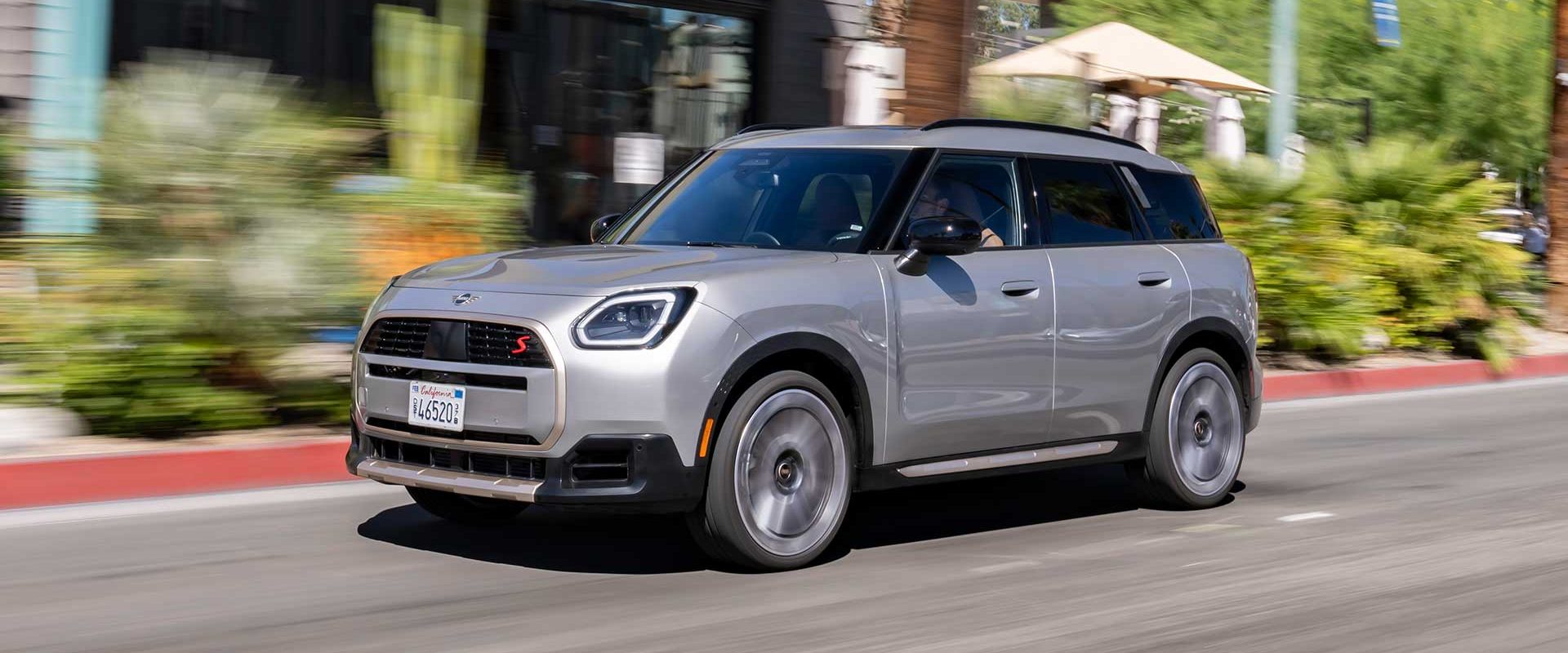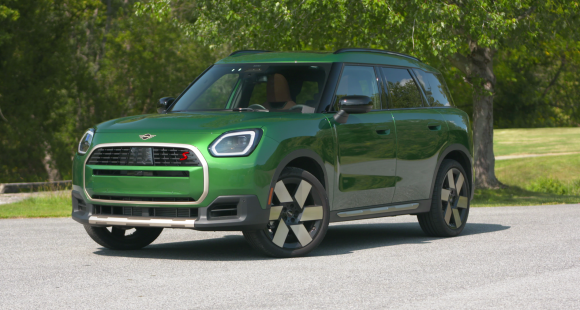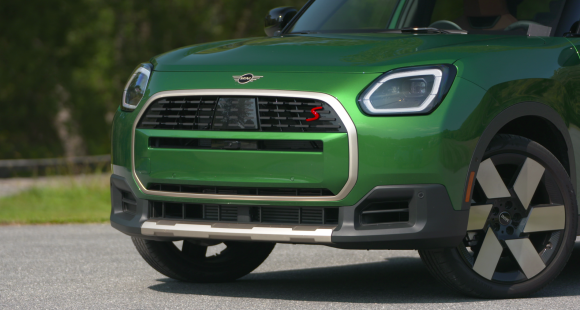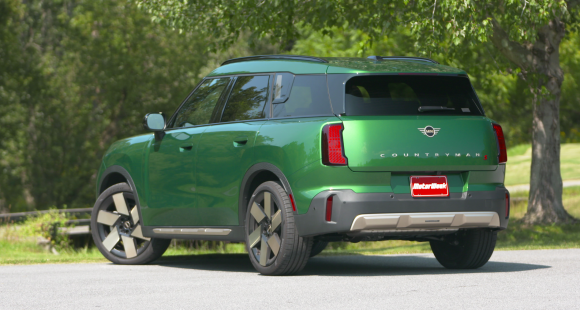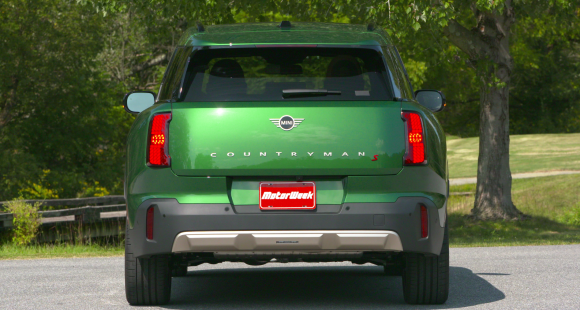Honda’s brand of practicality is certainly well known, and the compact CR-V crossover has been a core part of that story for 20-years now. Still, like the rest of the things on this earth, the CR-V must evolve if it wants to keep roaming our roads. Let’s see how this 5th generation CR-V has changed with the times.
While evolution is necessary for survival, it can still be a scary proposition. And that brings us to the 2017 Honda CR-V.
Where changes include first time turbo power, though it’s a small 1.5-liter with 190-horsepower that we’re talking about here. The I4’s 179 lb-ft. of torque makes it feel plenty adequate on daily commutes, a bit less so when fully loaded climbing hills.
It’s still the peppier of the two available engines, the other being a carryover 2.4-liter naturally-aspirated 184–horsepower I4 that’s offered now only in base LX.
Both are CVT-equipped, and that means sometimes excessive engine noise that we’re still getting used to in a Honda product. No complaints on its performance however, as it’s one of the best CVTs out there.
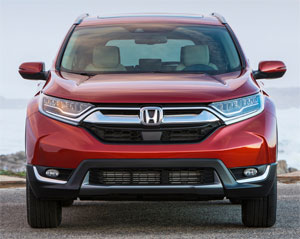 The reving racket is most noticeable, because the rest of the interior experience is an extremely quiet one.
The reving racket is most noticeable, because the rest of the interior experience is an extremely quiet one.
Front-wheel-drive remains standard, with all-wheel-drive a $1,300 option.
On the road, the new Civic-based chassis delivers a good deal of confidence; as it remains flat under hard cornering, yet still offers a smooth, stable ride.
Inside and out, everything looks and feels more substantial than previous CR-Vs; and while visibility was already good, it has improved with slimmer A-pillars.
Our example is of course top level Touring trim and everything inside is clean, modern, and upscale in appearance.
Typical for Honda, no actual gauges in the cluster; just a digital speed readout and virtual tack. But it passes our eye test, being easy to read at a quick glance.
Seat comfort wasn’t as great as we’d like, and the seat bottoms remain too short; but neither are deal-breakers.
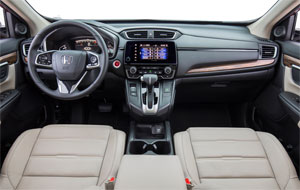 And we can’t thank Honda enough for bringing back an honest to goodness radio volume knob, while ditching their awkward center stack dual screen setup.
And we can’t thank Honda enough for bringing back an honest to goodness radio volume knob, while ditching their awkward center stack dual screen setup.
New this year is an available Hands Free Access Power Tailgate. Like others it opens the hatch with a quick sweep of the foot beneath the bumper.
Once opened, there’s enough room back here to easily incur extra baggage fees at the airport. Volume is 39.2 cubic-ft. in the cargo area, and 75.8 cubic-ft. with the seat backs folded. That’s more than Acura’s midsize MDX.
Safety systems are comprehensive, with much-appreciated blind spot monitoring and Collision Mitigation Braking standard on all but the base LX.
Physically larger than last generation, with 1.6-additional inches of wheelbase, the CR-V certainly has more visual presence than before.
Highlighting the back end are wing-shaped LED lights and dual exhaust tips.
While there is adequate power for the street; for the test track, our all-wheel-drive CR-V felt weak off the line, delivering us to 60 in a mediocre 7.5–seconds.
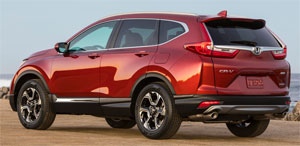 Once the turbos, engine RPM, and noise all get cranking; things improve greatly, as we buzzed our way through the ¼-mile in 16.0–seconds at 89 miles-per-hour.
Once the turbos, engine RPM, and noise all get cranking; things improve greatly, as we buzzed our way through the ¼-mile in 16.0–seconds at 89 miles-per-hour.
Handling is where this latest CR-V’s light shines the brightest. It felt almost athletic through the cones; with no top heavy feel, very little understeer, and quick steering.
With a 108-foot average stopping distance from 60, braking performance was equally impressive.
Government Fuel Economy Ratings are another strong point, 27-City, 33-Highway, and 29-Combined; with our average at the low end at 27.0 miles-per-gallon of Regular grade.
The Energy Impact Score is average at 11.4-barrels of yearly oil use, combined with 5.0-tons of CO2 emissions.
Typical for the segment, base pricing starts in the mid-20’s, at $24,985 for the LX; Touring trim begins at $33,335.
So, overall, just what do we think of the 2017 Honda CR-V? Well, the fact we picked it as our Drivers’ Choice Best Small Utility is pretty self-explanatory.
So, we’re not going out on a limb by forecasting that Honda will sell a lot of the new CR-Vs. Like the Civic, its formula of simple, inexpensive, practical, reliable transportation, that’s suitable for both young and old, continues on; only now with more style, more performance, and thus more appeal, to make even more CR-V fans.
Specifications
- Engine: 1.5 liter / 2.4 liter
- Horsepower: 190 / 184
- Torque: 179 lb-ft.
- 0-60 mph: 7.5 seconds
- 1/4 mile: 16.0 seconds @ 89 mph
- EPA: 27 mpg city / 33 mpg highway
- Energy Impact: 11.4 barrels of oil/yr
- CO2 Emissions: 5.0 tons/yr
Long Term Updates
Mileage: 2,100Our 2017 Honda CR-V has been with us for 2-months now, and it’s easy to see why it was such a runaway winner as Best Small Utility in our latest Drivers’ Choice Awards.
It really does offer tons of space in an easy to drive package, making it simple and efficient to go about running weekend errands; exactly the reason compact crossovers are so popular.
Despite our early misgivings, with this CR-V Touring package’s 1.5-liter I4 turbo, it’s 190-horsepower has proved more than adequate. Our fuel economy average is off to a good start too at 28.8 miles-per-gallon; right where the Combined rating says it should be.
Inside, we love that Honda has given us a volume knob for the radio, but still hate that we have to take our eyes off to road too much to use the touchscreen for station tuning; and hair trigger steering wheel controls take a lot of getting used to as well.
And we’ve got nothing but time, as our year of CR-V is just getting rolling.
Mileage: 5,000We’re 3-months in and very much enjoying the roomy interior and confidence inspiring ride. Though we haven’t added too many miles since last report, 2,100; it handles a lot of commuting chores; bringing our total to just over 5,000. Everybody must be taking it easy on the 1.5-liter turbo-4, as mileage is so far a stellar 31.5 miles-per-gallon.
Surprisingly, there’s been zero complaints about the CVT transmission; just the usual touch-sensitive control nitpicks. But, then, we’re just getting to really know the CR-V and it has a lot of hot driving months ahead.







 The reving racket is most noticeable, because the rest of the interior experience is an extremely quiet one.
The reving racket is most noticeable, because the rest of the interior experience is an extremely quiet one.  And we can’t thank Honda enough for bringing back an honest to goodness radio volume knob, while ditching their awkward center stack dual screen setup.
And we can’t thank Honda enough for bringing back an honest to goodness radio volume knob, while ditching their awkward center stack dual screen setup. Once the turbos, engine RPM, and noise all get cranking; things improve greatly, as we buzzed our way through the ¼-mile in 16.0–seconds at 89 miles-per-hour.
Once the turbos, engine RPM, and noise all get cranking; things improve greatly, as we buzzed our way through the ¼-mile in 16.0–seconds at 89 miles-per-hour.